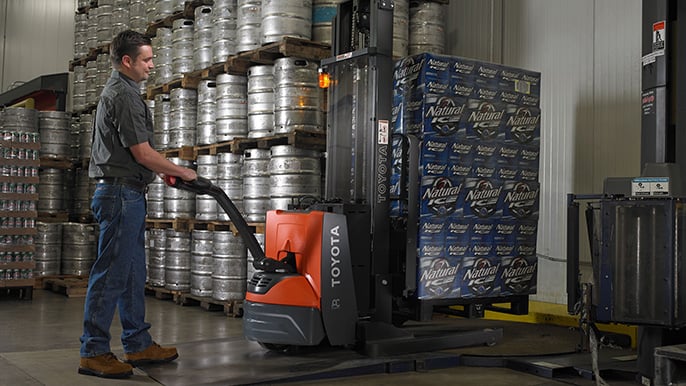Walkie stacker forklifts are a versatile and efficient choice for businesses managing materials handling in warehouses, retail backrooms and light industrial environments. Compact and easy to manoeuvre, they are particularly effective in tight spaces where larger forklifts may not fit. However, like all materials handling equipment, walkie stackers require proper use and adherence to safety practices to ensure smooth and accident-free operations.
At Toyota Material Handling Australia (TMHA), safety is at the core of every product and service offered. If your business is investing in or already operating a walkie stacker, the following safety tips will help keep your workplace safe and efficient.
1. Conduct Pre-Operation Checks
Before starting any shift, operators should carry out a visual inspection and functional check of the walkie stacker. Look for:
- Damage or cracks to forks and mast
- Battery charge and fluid levels (for lead-acid models)
- Tyre wear or damage
- Operational brakes, horn and emergency stop functions
- Hydraulic leaks or unusual noises
Identifying potential issues early prevents breakdowns and reduces the risk of accidents.
2. Use Proper Operating Techniques
Walkie stackers are controlled by walking alongside or behind the unit. To maintain safety:
- Always face the direction of travel.
- Keep a firm grip on the tiller arm.
- Operate at a safe walking pace, especially in high-traffic areas.
- Never ride on the equipment, walkie stackers are designed strictly for pedestrian operation.
Correct handling helps reduce strain and ensures better control.
3. Be Aware of Load Limits
Each walkie stacker has a maximum rated capacity, which must never be exceeded. Overloading reduces stability, strains the hydraulic system and increases the risk of tipping.
Ensure loads are evenly distributed and centred on the forks. Tilt the load back slightly when moving to maintain balance and visibility.
4. Maintain Clear Visibility
Obstructed vision is one of the most common causes of forklift incidents. Operators should:
- Avoid stacking loads too high.
- Use spotters if visibility is blocked.
- Travel in reverse if carrying large loads that obscure the front view.
- Keep pathways clear of clutter to minimise blind spots.
Toyota walkie stackers are designed with compact masts to improve forward visibility, but operator awareness remains essential.
5. Operate in Suitable Environments
Walkie stackers are ideal for smooth, level surfaces and indoor use. They are not designed for rough terrain or outdoor heavy-duty applications. Ensure the work environment is appropriate and avoid hazards such as wet floors, steep inclines or uneven surfaces that may affect stability.
6. Prioritise Pedestrian Safety
Since walkie stackers are operated in close proximity to people, protecting pedestrians is vital. Operators should:
- Use warning horns when approaching intersections or blind corners.
- Slow down in pedestrian-heavy areas.
- Ensure marked pedestrian walkways are respected.
- Never allow unauthorised staff to operate the equipment.
7. Keep Up with Regular Maintenance
Routine servicing is critical to safety and performance. Toyota Material Handling Australia provides national service coverage to keep your walkie stacker in optimal condition. Regular maintenance ensures that brakes, hydraulics, and batteries remain reliable throughout daily use.
A walkie stacker can significantly improve materials handling efficiency in confined spaces, but safe operation is essential. By carrying out pre-operation checks, respecting load limits, and prioritising pedestrian safety, businesses can ensure reliable performance and protect both operators and staff.
Toyota Material Handling Australia offers a wide range of walkie stackers backed by expert training and national service support. To explore available models, visit Toyota Material Handling Australia and connect with a Toyota specialist today.






